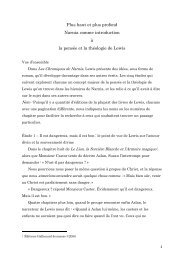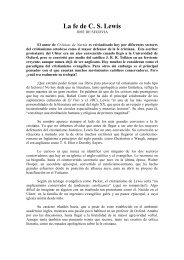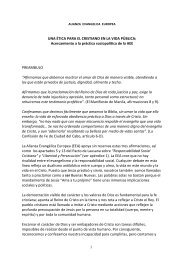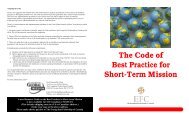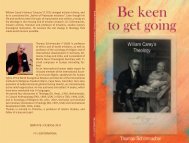- Page 1 and 2:
Jim Chew currently mentors cross-cu
- Page 3 and 4:
“No one better understands the is
- Page 5 and 6:
I wholeheartedly commend this book
- Page 8 and 9:
WHEN YOU CROSS CULTURES: Vital Issu
- Page 10:
To Selene, my loving wife and mothe
- Page 13 and 14:
xii
- Page 15 and 16:
I commend the book and its message
- Page 17 and 18:
xvi
- Page 19 and 20:
“tentmakers” are intentional in
- Page 21 and 22:
did the printing for the first edit
- Page 23 and 24:
2 WHEN YOU CROSS CULTURES
- Page 25 and 26:
4 WHEN YOU CROSS CULTURES “back h
- Page 27 and 28:
6 WHEN YOU CROSS CULTURES what is u
- Page 29 and 30:
8 WHEN YOU CROSS CULTURES In other
- Page 31 and 32:
10 WHEN YOU CROSS CULTURES Later, P
- Page 33 and 34:
12 WHEN YOU CROSS CULTURES CHAPTER
- Page 35 and 36:
14 WHEN YOU CROSS CULTURES CHRIST
- Page 37 and 38:
16 WHEN YOU CROSS CULTURES Question
- Page 39 and 40:
18 WHEN YOU CROSS CULTURES Paul was
- Page 41 and 42:
20 WHEN YOU CROSS CULTURES contextu
- Page 43 and 44:
22 WHEN YOU CROSS CULTURES CHAPTER
- Page 45 and 46:
24 WHEN YOU CROSS CULTURES When the
- Page 47 and 48:
26 WHEN YOU CROSS CULTURES The task
- Page 49 and 50:
28 WHEN YOU CROSS CULTURES CHAPTER
- Page 51 and 52:
30 WHEN YOU CROSS CULTURES lunch ho
- Page 53 and 54:
32 WHEN YOU CROSS CULTURES win thei
- Page 55 and 56:
34 WHEN YOU CROSS CULTURES CHAPTER
- Page 57 and 58:
36 WHEN YOU CROSS CULTURES
- Page 59 and 60:
38 WHEN YOU CROSS CULTURES INTRODUC
- Page 61 and 62:
40 WHEN YOU CROSS CULTURES • Expl
- Page 63 and 64:
42 WHEN YOU CROSS CULTURES A CREATI
- Page 65 and 66:
44 WHEN YOU CROSS CULTURES E COMMIS
- Page 67 and 68:
46 WHEN YOU CROSS CULTURES Orchestr
- Page 69 and 70:
48 WHEN YOU CROSS CULTURES BIBLICAL
- Page 71 and 72:
50 WHEN YOU CROSS CULTURES In their
- Page 73 and 74:
52 WHEN YOU CROSS CULTURES a turnin
- Page 75 and 76:
54 WHEN YOU CROSS CULTURES Christia
- Page 77 and 78:
56 WHEN YOU CROSS CULTURES Nge Lian
- Page 79 and 80:
58 WHEN YOU CROSS CULTURES Bigger i
- Page 81 and 82:
60 WHEN YOU CROSS CULTURES authorit
- Page 83 and 84:
62 WHEN YOU CROSS CULTURES RECOMMEN
- Page 85 and 86:
64 WHEN YOU CROSS CULTURES
- Page 87 and 88:
66 WHEN YOU CROSS CULTURES BACKGROU
- Page 89 and 90:
68 WHEN YOU CROSS CULTURES poignant
- Page 91 and 92:
70 WHEN YOU CROSS CULTURES obedienc
- Page 93 and 94:
72 WHEN YOU CROSS CULTURES learn ab
- Page 95 and 96:
74 WHEN YOU CROSS CULTURES A good w
- Page 97 and 98:
76 WHEN YOU CROSS CULTURES and live
- Page 99 and 100:
78 WHEN YOU CROSS CULTURES can rela
- Page 101 and 102:
80 WHEN YOU CROSS CULTURES CHAPTER
- Page 103 and 104:
82 WHEN YOU CROSS CULTURES 2 Giving
- Page 105 and 106:
84 WHEN YOU CROSS CULTURES in the N
- Page 107 and 108:
86 WHEN YOU CROSS CULTURES FOR BIBL
- Page 109 and 110:
88 WHEN YOU CROSS CULTURES effectiv
- Page 111 and 112:
90 WHEN YOU CROSS CULTURES SPIRITUA
- Page 113 and 114:
92 WHEN YOU CROSS CULTURES One miss
- Page 115 and 116:
94 WHEN YOU CROSS CULTURES FOR BIBL
- Page 117 and 118:
96 WHEN YOU CROSS CULTURES Sensitiv
- Page 119 and 120:
98 WHEN YOU CROSS CULTURES home cou
- Page 121 and 122:
100 WHEN YOU CROSS CULTURES TENTMAK
- Page 123 and 124:
102 WHEN YOU CROSS CULTURES CHAPTER
- Page 125 and 126:
104 WHEN YOU CROSS CULTURES EVALUAT
- Page 127 and 128:
106 WHEN YOU CROSS CULTURES 4 The L
- Page 129 and 130:
108 WHEN YOU CROSS CULTURES SUMMARY
- Page 131 and 132:
110 WHEN YOU CROSS CULTURES also be
- Page 133 and 134:
112 WHEN YOU CROSS CULTURES PRE-FIE
- Page 135 and 136:
114 WHEN YOU CROSS CULTURES 6 Pract
- Page 137 and 138:
116 WHEN YOU CROSS CULTURES The cal
- Page 139 and 140:
118 WHEN YOU CROSS CULTURES Discuss
- Page 141 and 142:
120 WHEN YOU CROSS CULTURES The exa
- Page 143 and 144:
122 WHEN YOU CROSS CULTURES Here is
- Page 145 and 146:
124 WHEN YOU CROSS CULTURES A perso
- Page 147 and 148:
126 WHEN YOU CROSS CULTURES 7. Sinc
- Page 149 and 150:
128 WHEN YOU CROSS CULTURES 4. Valu
- Page 151 and 152:
130 WHEN YOU CROSS CULTURES Mission
- Page 153 and 154:
132 WHEN YOU CROSS CULTURES
- Page 155 and 156:
134 WHEN YOU CROSS CULTURES measure
- Page 157 and 158:
136 WHEN YOU CROSS CULTURES respond
- Page 159 and 160:
138 WHEN YOU CROSS CULTURES Adjusti
- Page 161 and 162:
140 WHEN YOU CROSS CULTURES and try
- Page 163 and 164:
142 WHEN YOU CROSS CULTURES CHAPTER
- Page 165 and 166:
144 WHEN YOU CROSS CULTURES 2 SUPPR
- Page 167 and 168:
146 WHEN YOU CROSS CULTURES Rationa
- Page 169 and 170:
148 WHEN YOU CROSS CULTURES CHAPTER
- Page 171 and 172:
150 WHEN YOU CROSS CULTURES • Pre
- Page 173 and 174:
152 WHEN YOU CROSS CULTURES CHAPTER
- Page 175 and 176:
154 WHEN YOU CROSS CULTURES 4 Pacin
- Page 177 and 178:
156 WHEN YOU CROSS CULTURES CHAPTER
- Page 179 and 180:
158 WHEN YOU CROSS CULTURES and the
- Page 181 and 182:
160 WHEN YOU CROSS CULTURES CHAPTER
- Page 183 and 184:
162 WHEN YOU CROSS CULTURES 3. Exam
- Page 185 and 186: 164 WHEN YOU CROSS CULTURES persona
- Page 187 and 188: 166 WHEN YOU CROSS CULTURES The fle
- Page 189 and 190: 168 WHEN YOU CROSS CULTURES PRACTIC
- Page 191 and 192: 170 WHEN YOU CROSS CULTURES CHAPTER
- Page 193 and 194: 172 WHEN YOU CROSS CULTURES Some As
- Page 195 and 196: 174 WHEN YOU CROSS CULTURES first c
- Page 197 and 198: 176 WHEN YOU CROSS CULTURES and app
- Page 199 and 200: 178 WHEN YOU CROSS CULTURES RECOMME
- Page 201 and 202: 180 WHEN YOU CROSS CULTURES
- Page 203 and 204: 182 WHEN YOU CROSS CULTURES Some wo
- Page 205 and 206: 184 WHEN YOU CROSS CULTURES THE TEN
- Page 207 and 208: 186 WHEN YOU CROSS CULTURES “What
- Page 209 and 210: 188 WHEN YOU CROSS CULTURES Case St
- Page 211 and 212: 190 WHEN YOU CROSS CULTURES An open
- Page 213 and 214: 192 WHEN YOU CROSS CULTURES CHAPTER
- Page 215 and 216: 194 WHEN YOU CROSS CULTURES 1. Do a
- Page 217 and 218: 196 WHEN YOU CROSS CULTURES Another
- Page 219 and 220: 198 WHEN YOU CROSS CULTURES person-
- Page 221 and 222: 200 WHEN YOU CROSS CULTURES As a si
- Page 223 and 224: 202 WHEN YOU CROSS CULTURES FOR BIB
- Page 225 and 226: 204 WHEN YOU CROSS CULTURES TENTMAK
- Page 227 and 228: 206 WHEN YOU CROSS CULTURES Brethre
- Page 229 and 230: 208 WHEN YOU CROSS CULTURES My wife
- Page 231 and 232: 210 WHEN YOU CROSS CULTURES (5) Fin
- Page 233 and 234: 212 WHEN YOU CROSS CULTURES APPENDI
- Page 235: 214 WHEN YOU CROSS CULTURES 2 nd Cr
- Page 239 and 240: 218 WHEN YOU CROSS CULTURES 6th Cri





